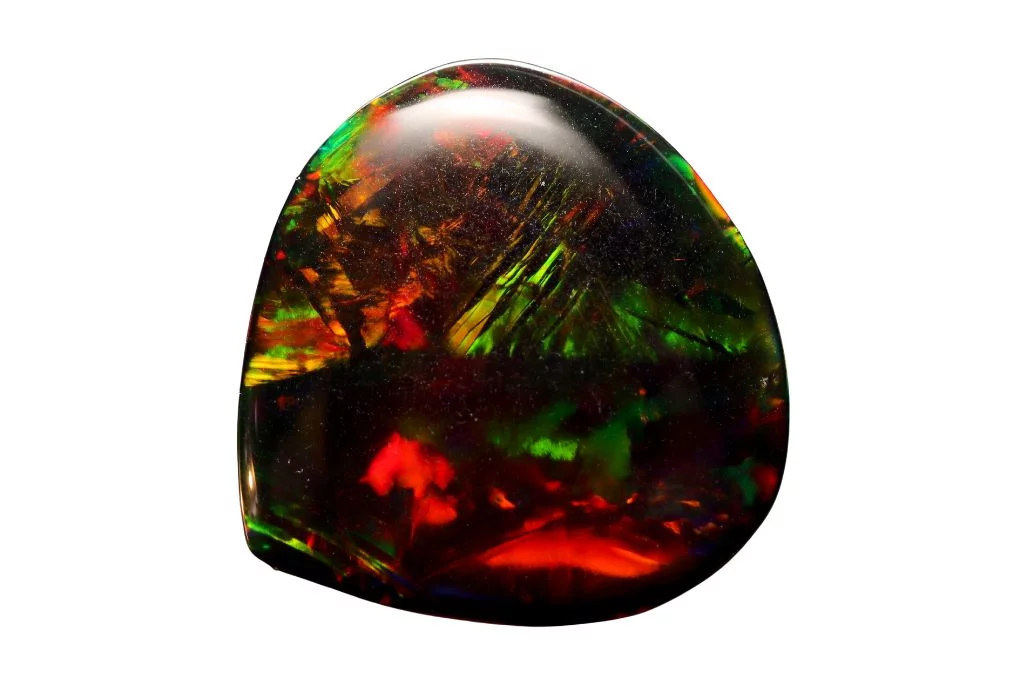The Appearance of Black Opal
Black opal is renowned for its captivating and mesmerizing appearance, setting it apart from other gemstones. At first glance, the most striking feature of black opal is its dark body tone, which serves as a canvas for the stone’s vibrant play-of-color. This background can range from a deep, inky black to dark gray or even a midnight blue, providing a stark contrast to the flashes of color that dance across its surface.
Vibrant Play-of-Color
The hallmark of black opal is its extraordinary play-of-color, which refers to the flashes of various hues that appear to move and shift as the stone is viewed from different angles. These colors can span the entire spectrum, including vivid reds, blues, greens, yellows, and purples. The intensity and pattern of these colors can vary greatly, with some stones displaying broad flashes while others exhibit intricate, pinfire patterns reminiscent of tiny, colorful dots.
Structural Characteristics
Black opal typically occurs in nodules or seams within its host rock. When cut and polished, it can take on various shapes and sizes, from small cabochons to larger, freeform pieces. The stone often has a smooth, glossy surface that enhances its color play. Some black opals may display a natural, rough texture on one side, known as the potch, which can add to their unique character.
Unique Features
What truly sets black opal apart is its ability to display multiple colors within a single stone, often arranged in mesmerizing patterns. Some specimens exhibit rare phenomena such as “harlequin” patterns, where the colors appear in distinct, angular patches, or “rolling flash,” where the colors seem to roll across the surface as the stone is moved. These distinctive features, combined with its dark body tone and brilliant play-of-color, make black opal one of the most sought-after and valuable varieties of opal in the world.
Historical and Cultural Significance of Black Opal
Black opal has been revered for centuries, particularly by Indigenous Australian cultures. The Aborigines of Australia considered these gemstones to be sacred, believing they contained the essence of the rainbow serpent, a powerful creation deity. In ancient Rome, black opals were thought to bring good fortune and ward off evil spirits.
Metaphysical Associations
Metaphysically, black opal is associated with intuition, insight, and spiritual awakening. It is believed to enhance psychic abilities and stimulate creativity. Many crystal healers consider black opal a powerful stone for protection, capable of absorbing and transforming negative energies. The stone is also thought to aid in releasing fears and insecurities, promoting inner strength and self-confidence.
Common Uses and Benefits
In modern times, black opal is primarily used in jewelry, prized for its unique play of color and rarity. However, it is also employed in various alternative healing practices. Crystal therapists use black opal to balance the root and sacral chakras, believing it can help ground excess energy and promote emotional stability. Some people carry black opal as a talisman for luck and protection during travel or important life events.
Traditional and Modern Applications
Traditionally, black opal was used in divination practices and shamanic rituals. Today, it is often incorporated into meditation and mindfulness exercises. Many individuals use black opal in their personal energy work, placing it on the body during relaxation or holding it while visualizing goals. In feng shui, black opal is sometimes used to enhance the water element in a space, promoting flow and abundance.

